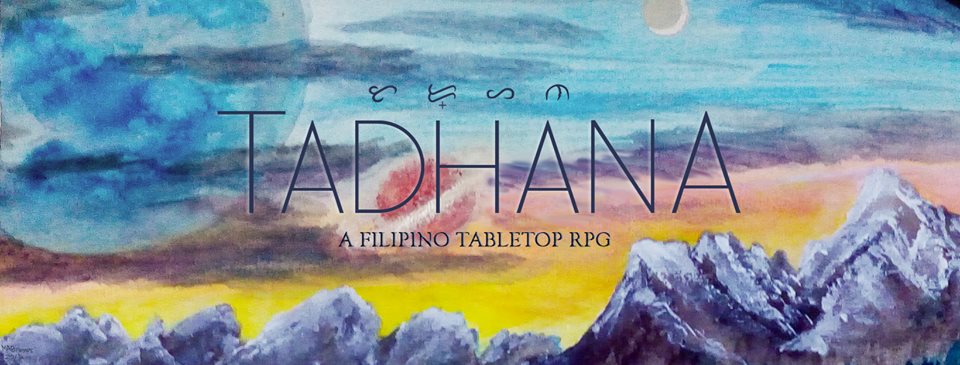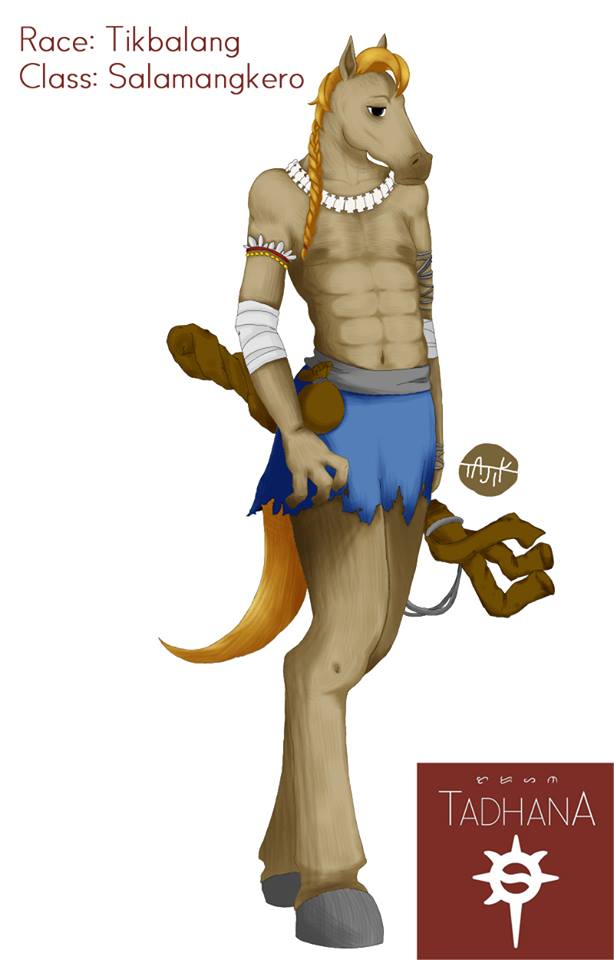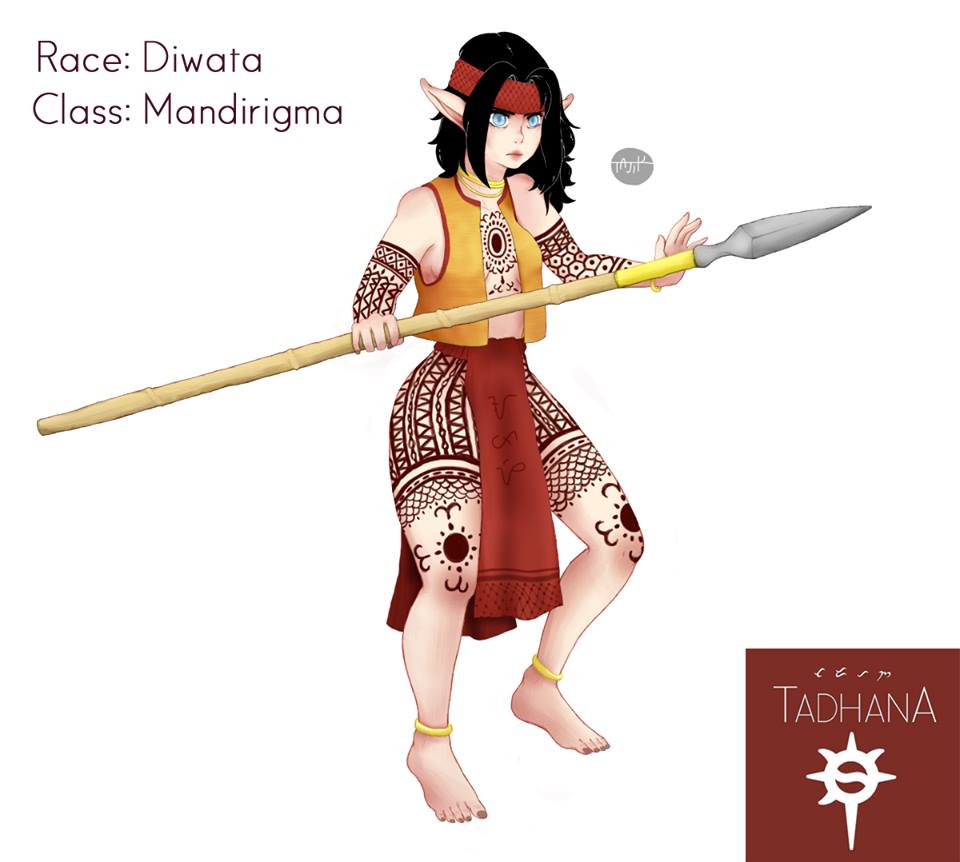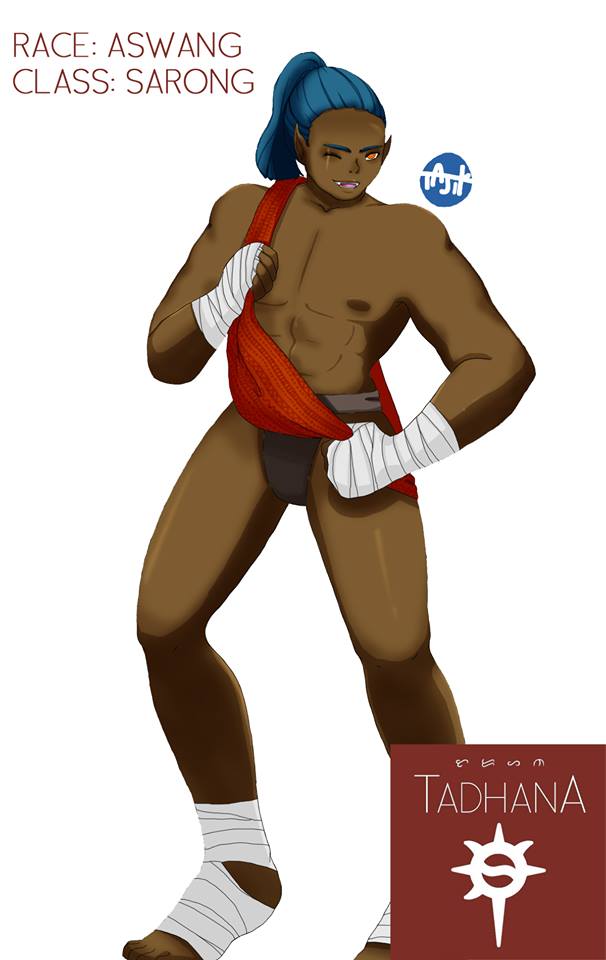
Imagine a world of monsters and men where you can become a magic wielding Tikbalang, summoning the wrath of nature to destroy the hordes of evil Berbalang terrorizing a helpless community of Diwata? Or how about a fist fighting Aswang doing his “dance of death” against an angry Kapre – crushing its bones and biting its flesh along the way?
Tadhana, is a new local tabletop game that brings us closer to the multitude of creatures from Philippine folklore and myth. It fuses the elements of role playing games with a kick-ass story that will give anyone enough reason to fall in love with the magical and mystical stories of the past. Create your own adventure while playing your favorite Philippine mythical being from a beautiful Mandirigmang Diwata to an enigmatic Albularyong Engkanto.
Last October 15, 2017 at Komiket, I found myself activating my “geek mode” full blast as I scored a chance to interview the team behind Tadhana. Headed up by their Lead Writer and Developer John Nathan Briones, together with Rachel Joy Quirante, Maria Asuncion Briones, Nikita Panganiban, Sinta Posadas, Ledelou Apale, Ezekiel Joachim Briones, Fraime Barcelo, Robert Merrera and Katherine Briones (the last 3 of whom were not present for the interview), Project Tadhana generously shared their inspiration and undying love for our very own mythology that give birth to the first Philippine Mythology based tabletop RPG.
An interview with the team behind TADHANA
We know that most RPG tabletop games like Dungeons and Dragons and Pathfinder are heavily inspired by various mythology. With Project Tadhana, can you tell us the story behind the idea of the of the first local RPG game based on Philippine Mythology?
Nathan: We are actually tabletop players before and played the likes of Dungeons and Dragons and board games like Munchkins. I’ve seen the work of Nosfecatu , a guy who created Philippine mythology creatures for Dungeons and Dragons campaigns around 3 or 4 years ago and then that’s when I began to ask ‘Why don’t we have a Filipino based tabletop RPG game where it will feature the creatures from Philippine mythology?’ to think we’ve got so many creatures/monsters from our own mythology where we can draw an inspiration like Wak-Wak or Sigbin.
Sinta: Also the pantheons of gods of ancient Filipinos. Every areas in the Philippines has their own different sets of deities which makes it so diverse as if there is a “multiverse” in our very own lore. They have their own gods and goddesses for almost anything, even from the most trivial things to every living thing. They plan everything that will happen – like seasons, which allows us to see that there is some kind of divine influence on everything that happens. The question “Do these gods and goddess such as Kaptan interact with one another? Do they know each other?” It made us think that the flavors and fluffs these elements bring is a good setting for a tabletop RPG. The magic and mysticism is very alive in Philippine culture.”

When it comes to designing your characters, did you base it on the existing depiction from our lore or did you make some creative changes with them?
Nikita: Regarding the character design, the team gave me a description and the back story behind them. During the brainstorming for example, we researched about what makes a Diwata look like a Diwata. We try to pinpoint what makes these characters Filipino. We don’t want the people to think that a Diwata is an Elf. No! Diwata is not an Elf (laughter). As an artist I wanted to do justice to the characters, but I also wanted to be faithful in the lore and to the original description of the characters themselves.
Nathan: It’s just quiet a challenge because there is so many versions (of Philippine myth creatures).(Laughter)
Ledelou: For the monsters, as much as possible, we also wanted to stick with their actual description based on our lore. For my part I did research regarding their common interpretation and appearances like the Buwaya – which at first when they tell me to draw a Buwaya (Crocodile), I ask myself if should I draw a normal crocodile or if its anthropomorphic (with human like characteristics). Then after my research I found out that the Buwaya in our lore carries a coffin or an item that looks like a ‘baul’ (container) which is what I integrated in my creation. Another is the Wak-Wak which in some lore is described as a bird like being with big talons and wings that resemble a bat. All in all we really tried to make every design faithful.
Maria: In addition to the character and monster design, the landscape and backgrounds posed some difficulties which was a bit tricky. We made the world in Tadhana divided in two Folds (Regions), namely the upper and lower folds wherein there are colder regions. I got this idea that maybe specific locations in the game will be based on specific Probinsya (Province) in the Philippines as well as some iconic places in our country. Other than that, we also made some changes regarding the game environment. For example, Sekunda’s sky (the name of the world in Tadhana) has three moons. So from that idea we began to conceptualize how it will become distinct and at the same time bear a Filipino flavor. I put in the idea then that three moons were composed of different colors like red, blue and white, which represent the Philippine Flag. We wanted to incorporate small things like that in the game itself.
Nathan: Actually we are quiet scared when we are conceptualizing the landscape. When you are creating an RPG game, more than the lore or story, you also have to include some “science” or logical aspect. Say for example, when did these three moons appear? Knowing the Philippines is a tropical place, how is it possible to have more seasons like winter in the game setting?
Maria: In Tadhana, we even created the center of the universe or the planetary system not as a stereotypical star but a black hole. But planets surrounding a black hole wouldn’t have life, so we think about their distance as well as what climate could be made to make it possible.
Nathan: So to make the game setting remain tropical like the Philippines, we created a black hole like sun as the center of the solar system. I was inspired from the movie Interstellar, although I found out later on that the physics behind the movie is fictional. I learned that when a planet is at a specific distance, it will not get any heat from the sun itself but from the cosmic heat in space like “left over” heat. With that, we made the universe in Tadhana on the scheme of “hot sky, but cold sun” which made Sekunda a tropical planet. We also reversed it in a way that night happens in the part of the planet which is facing the black hole and vice versa. During morning is the only time the three moons rise in the sky and the “sun” appears during the night time. We did create a really strange world (in Tadhana). (laughter)

Did you encounter some challenges while researching our mythology for the story or concept of Project Tadhana?
Nathan: It’ss really hard when it comes to researching the lore. The monsters in our myth have different versions. The Diwata itself has a different description base in each region or culture from different provinces, as well as Engkantos. We also read that in some regions, they consider that the Tamawo and Engkanto is actually one in the same. There are so many interpretations.
We found out then we can’t be “loyal” to any single source or depiction, so we consulted one another regarding the creation of the lore of Tadhana. We asked ourselves if we can make some artistic liberty on the designs and depictions. Then I came up with the idea that in Tadhana, the Engkantos and Tamawo will be a separate entities. I am very fond of the Tamawo’s description of having a metallic quality in their hair – with shades of gold, silver or platinum and I really wanted to see that kind of race in the game.
For the Tamawo, I made it as a sexless race so I really admit there are lots of artistic changes that I made regarding the characters, but at the same time I wanted the characters to still have a reference to the region they come from. What we did with the race of Tao (human) is making them come from countries that are based on real places in Philippines – like the Nilenyo Kingdom which is based on Manila, the Bayan of Darang’n which happens to be inspired by the Maranao region, and the stairs of Makununggan is reminiscent of the Banaue Rice Terraces of Ifugao.
I’ve really loved the Tikbalang race ever since I finished reading the Mythology Class by Arnold Arre. It is a very popular creature but I wanted to give it a twist. In pop culture, they usually act as guardians, trickster or an enemy. They are also very diverse, so we decided to make them a great race in the game. One time during my class in senior high, one of the students asked me “Sir, is it possible that we have a unicorn since we have a Tikbalang?”. After researching, I found out that Tikbalangs are strictly male. However, there is a female centaur like creature called Anggitay which possesses a rainbow like mane and looks like a unicorn with their horns.
It gave me the idea that in the lore of Tadhana, Tikbalangs can be both male and female and their leader will be an Anggitay. Those are some of the artistic liberties we take in the game.
Sinta: Another thing with the artistic liberty is when Nathan and I talked about it, we believed that artists and writers are allowed to take artistic liberty, but one must still pay proper respect to the original source. But how can we say original when it comes to Philippine lore? It’s so diverse and has many interpretations too. Does the original mean they are the first one when it comes to the date or period? What is the newest and oldest version?
Nathan: You can’t even tell who or what is the original since it’s bastardized when it was transferred from generation to generation.
Sinta: I think “bastardize” is not the right term to coin it but rather to change or evolve. It evolves when it was transferred word per word via oral tradition. It adapts depending on the current culture. Stories from the past usually evolve in their context from the day they were created. So I think we are allowed to create new context out of it in our current time.
How did you come up with the idea of a spell casting Tikbalang and a martial artist aswang?
Nathan: We decided that in the game all professions (Mandirigma, Salamangkero, Sarong or Martial Artist, etc.) will be accessible to any race. For the aswang, if you look at TV shows and films, aswangs are depicted with different facets, like they were modernized. I am also inspired by Mervin Malonzo’s aswang characters in his comic, Tabi Po and how he made them based on Noli Me Tangere. With those ideas, we made the races in Tadhana to play different jobs or professions and asked ourselves ‘what will these races do when they play this certain profession?’. They can be a Sarong or anything.
Sinta: In a typical RPG, it is normal that each race can play almost all different classes and professions, and mix them. There are some conventions but it’s not bad – for example, to make your Tikbalang a Mandirigma by profession. It’s good to explore non-conventional combinations of races and classes in RPG. So, it is possible to have an Albularyong Aswang although it’s quiet weird. (laughter)
Nathan: If you think about, it’s like a chance for the Albularyong Aswang. He can kidnap someone, heal their sickness, but will later make him or her his servant by biting him and infecting him ala Dracula. (laughter)
What are the creatures, figures/icons from Philippine Mythology that you have currently incorporated into Project Tadhana?
Nathan: Right now, the starter campaign of Tadhana which is “Bulong” is heavily base on the tales of Hinilawod from Iloilo – which I am very proud of since I came from the said province. For the monsters, there are the Tianaks, Batibat, Kapre and the likes, which are the most common. For races we have the Aswang, Diwata, Garuda (Bird like people) and Engkanto.
Just to prevent some spoilers (laughter) all the events and scenarios in Bulong are like a throwback to the story of Hinilawod, so you might expect some familiar characters coming from the said epic once you play the campaign.

Which among the classes/races and monsters is your most favorite in Tadhana and why?
Sinta: Albularyo! Solid! I actually like the combination of Tao and Albularyo, but honestly I really love the Diwata which I derived my original pen name “Diwata ng Manila”. Albularyo is a good profession, like you have the powers over life and death. I like the fact that you can act like a healer but you can be a bit “darker” too.
Ledelou: Mandirigma! (laughter)
Nathan: My favorite class will actually be released in the future, so it is not yet available in the game – like the Huni which a Bard like class. As for me, my favorite class is called Lumamon which is a mix of Albularyo and Sarong under the aswang race.
Maria: I pick Babaylang Tamawo. I am really drawn into the genderless race of Tamawo and I really, really love the UP Babaylan which is a university LGBT group.
What are the future plans of Project Tadhana when it comes to exploring our Philippine lore and adding more exciting features for RPG tabletop?
Nathan: We are planning to add more races from our lore as well as prestige classes like Anito and Tamawo. Anito will be an ageless race and Tamawo are genderless with distinct metallic like hair. We will expand the lore as well and by December this year, we will be releasing a free campaign that can be downloaded. It’s the continuation of Bulong namely “Pito” (whistle). Next year we will hopefully publish an Overseers Manual and Bestiary where it lists all the monsters and creatures that players will encounter when they play Tadhana.
Other than that, we are hoping to ship the materials for Tadhana internationally and even publish them in Filipino languages so that we can make it accessible. We are even thinking about the possibility to make Tadhana a learning tool for the younger generation to become aware of our own mythology.
Tadhana was released this October and will be launch soon onto the RPG market .You can visit their Facebook page (Project Tadhana) for your dose of updates and news regarding the game.
ALSO READ: TAG SESSIONS: Review of TADHANA by TOBIE ABAD
Currently collecting books (fiction and non-fiction) involving Philippine mythology and folklore. His favorite lower mythological creature is the Bakunawa because he too is curious what the moon or sun taste like.


